Multimedia, Politics
Velvet Revolutions, twenty years later
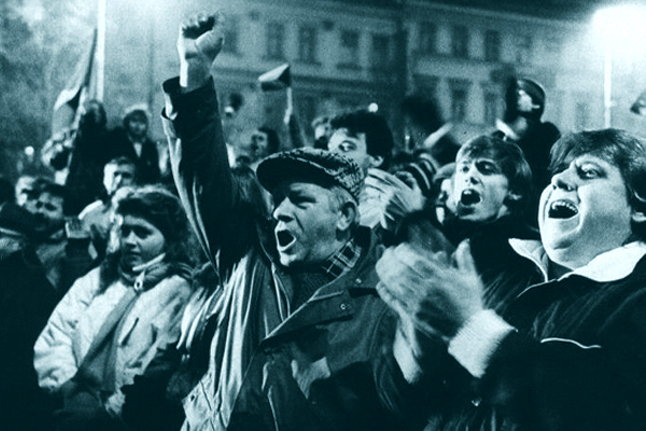
Young is the one that plunges in the future and never looks back When the heart speaks, the mind finds it indecent to object -- Milan Kundera
For older people, Czechoslovakia inevitably comes in a sentence that includes Hitler, Munich, Chamberlain, Daladier, appeasement, World War II and the falling of dominoes. Well, OK, technically, dominoes comes from just after World War II, but the dominoes threaten to fall in Southeast Asia precisely because of a presumed failure to learn those lessons of Munich. Neville Chamberlain, after all, has given us the final justification for appeasement when he explained to Britain in 1938 how “incredible it is that we should be digging trenches and trying on gas-masks here because of a quarrel in a far away country between people of whom we know nothing.”
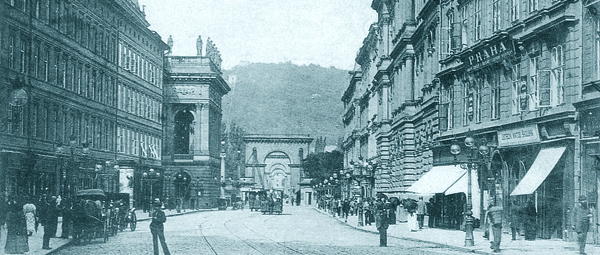
Photo: Prague, circa 1900
For those steeped in high culture, the Habsburg provinces that became Czechoslovakia in 1918 were an integral part of the civilization of 19th and 20th century Mitteleuropa. Even while part of the Austro-Hungarian Empire, it produced composers like Antonin Dvorak, Bedrich Smetana, Leos Janacek and Gustav Mahler; the first two among the pre-eminent nationalist musicians of the 19th century; the latter two early explorers of the existential angst of the 20th century.
More recently, filmmaker Milos Forman mined the old for an understanding of our own time, and the writer Milan Kundera explored the excitement of creating a new political and social world. Vaclav Havel’s dramas, meanwhile, offered a road map to follow the fate of free thought in a repressive world.
And writers like Jaroslav Hasek (The Good Soldier Svejk), Franz Kafka and Karel Capek each offered their distinctive voices in world literature as well. Hasek created the model for every work-shirking, renegade inside a military machine, exemplar for so many others like Yossarrian in Catch 22 – and even an emotional contributor to this article’s author’s response to his own time in the Vietnam-era American army.
Kafka’s name, of course, is now the very synonym – Kafkaesque – for the inexplicable grinding down by bureaucracy of ordinary people. And Capek imagined a time when men are increasingly replaced by machines, in his play, RUR; or a world where nature itself rebels against its mistreatment in the hands of men – War with the Newts — the world’s first ecological novel. (Of course, neither Kafka nor Mahler were ethnic Czechs, coming as they did from German Jewish backgrounds. They did, however, grow up in the then-Austrian ruled province of Bohemia and imbibed a healthy dose of the prevailing cultural ethos of the region, in addition to their own families’ background.)
And we should also remember a whole clutch of first rank Czech tennis stars, Bata shoes and Skoda motor vehicles (and tanks) — and perhaps most important of all, Bohemia and Moravia as the ur-home of Budweiser, as well as even better tasting brewskis.
For a historian, the Czech lands and people have been pivotal – beyond Munich and what followed. Think Jan Hus and the beginning of the Reformation, White Mountain and the horrors of the Thirty Years War; or perhaps even the Czech Corps (first as prisoners of war in Russia during World War I, then as rebellious Austro-Hungarian army soldiers, and eventually liberated but still trapped inside a chaotic, revolutionary Russia) as they make their way across Siberia. They accidentally trigger the deaths of the last Romanovs as the Red Army fears this ragged, homesick Czech remnant is coming to rescue the Czar.
The country is finally freed from 400 years of Habsburg rule, created as an independent country under the Treaty of Versailles and Woodrow Wilson’s Fourteen Points; and it has a brief democratic interlude until France and Britain barter it for “peace in our time”. A year later the remainder is incorporated into the Third Reich. They are finally liberated from the Germans – but only after World War II ends – and then only to fall into the Soviet orbit, and the abyss. One could easily call this unhappy history.
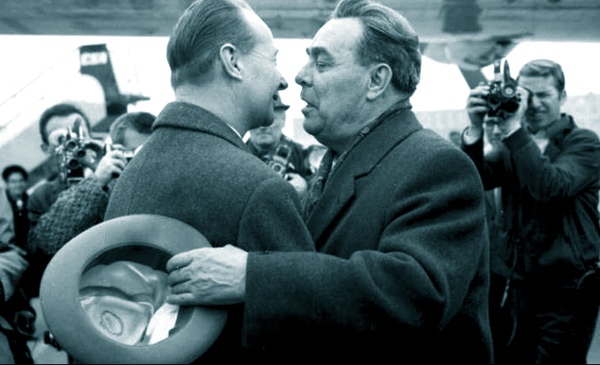
Photo: Alexander Dubcek and Leonid Brezhnev
But, then, 1968 is the year of Mao’s “Little Red Book”, Rudi the Red’s Paris student revolt, the days of reckoning after the Tet offensive, assassinations of Martin Luther King Jr. and senator Robert Kennedy, racial riots in America’s cities, anti-Vietnam War protests, – and, then, along with everything else, the elevation of Alexander Dubcek as head of the government in the Czech spring.
Dubcek and other secret reformers in Prague have been searching for a middle way between Russian domination and joining up with the west; between orthodox Marxist socialism and western-style, untrammelled capitalism. The Russians watch and wait to see how it will turn out.
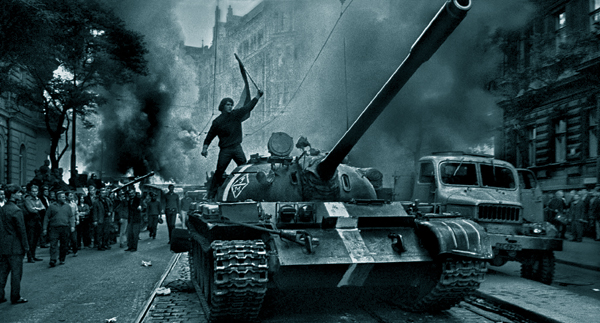
Photo: Soviet tanks on streets of Prague, 1968
Soon enough they have had enough; tanks and troops from the other Warsaw Pact armies invade; they crush the reformist government and exile Dubcek to an administrative job in the Czech bundu. Gustav Husak comes into power, and the regime turns the country into a model satellite. The motto is: keep your head down. For another generation.
But then a miracle, perhaps. First the slow unravelling of Polish Communism under the cumulative impact of the Solidarity trade union in Gydansk under Lech Walesa and Andrzej Wajda’s films like “Men of Iron”, Pope John Paul II and increasingly inept responses from a sclerotic Polish government. Then there is also the growing impact of Mikhail Gorbachev’s perestroika and glasnost throughout Eastern Europe, and a reluctance by Mikhail Gorbachev’s government to send troops into its East European satellites to reassert control. Even news of the (ultimately unsuccessful) Tiananmen Square protests in May 1989 contribute to a growing spirit of liberation in Eastern Europe.
The Soviet Union’s new doctrine of non-intervention in Eastern European states continues even when a non-communist government takes office in Warsaw in September. And in Hungary, another multi-party regime takes hold in October and its leaders speak out about the need for Soviet troops to “go home”. And then, the fall of the wall in Berlin. The Kremlin’s willingness to abandon a key ally like East Germany is the turning point.
Pivot now to Czechoslovakia. Students and intellectuals have been meeting quietly for years to talk about a different future, but the first tangible catalyst is police violence against a peaceful student demonstration in Prague on Nov. 17 that had been convened to commemorate the death of Jan Opletal, a student leader during World War II. The demonstrators march to Opletal’s grave and, carrying on after the official march is over, they continue downtown to Wenceslas Square. Twenty years later, Vaclav Havel would tell his fellow Czechs, “The march set history into motion.”
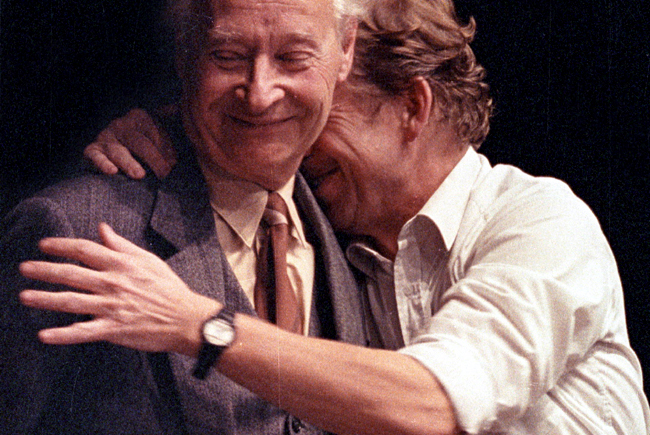
Photo: Vaclav Havel (R) hugs former Czech leader Alexander Dubcek upon learning that the entire Czech government resigned on November 24, 1989 in Prague.
A cordon of police who have blocked off the obvious exits confronts the demonstrators. The police move forward on Narodni Street, and then wade into the demonstrators with their truncheons. When all the protesters have been dispersed, one of the participants, actually a secret police agent, Luldvik Zifcak, stayed on the street, posing as dead. He is taken away later, and no one knows why he did this. However, the rumor of a “dead student” – reported by foreign media as well – becomes critical to what unfolds next. At a meeting in a theatre, students and theater actors agreed to go on strike and by November 20, the number of peaceful protesters who had assembled in Prague had grown to about a half million people.
Protest leaders call for a two-hour general strike on November 27 – the Prague demonstrations have now spread across the country. (As an aside, there has been debate for two decades as to whether the secret police quietly abetted this rebellion to force replacement of the ineffectual Communist regime with a stronger one. True or not, the revolt worked out very well, but not for the secret police.)
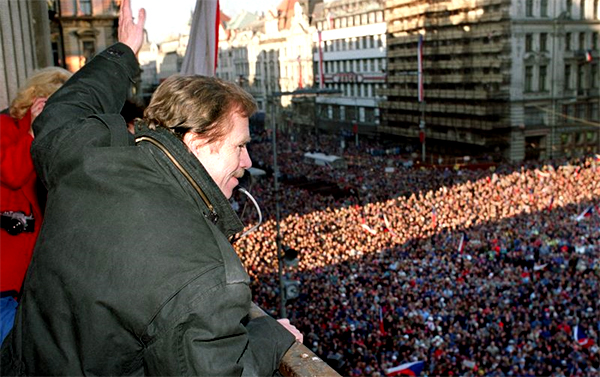
Photo: Vaclav Havel, dissident playwright, opposition leader and then soon-to-be president, waves to the crowd of demonstrators in Prague’s Wenceslas Square, 27 November 1989
Czechoslovakia’s Communist Party has a failure of will, and announces on November 28 an end to the single-party state. The barbed wire on the borders with West Germany and Austria are removed, and on December 10, an ancient Gustáv Husák appoints a mostly non-Communist government, resigns and shuffles off into history’s dustbin. Alexander Dubcek – he’s back! – is now speaker of the parliament and one of the country’s leading writer/dissent intellectuals, Vaclav Havel, is sworn in as president just as 1989 ends. (The tale ends on a slightly sour note, just a few years later, when the country breaks apart in the Czech Republic and Slovakia. Unlike the dissolution of Yugoslavia, the split of Czechoslovakia is peaceful, no fighting, no bloodshed. Probably the biggest issue is what to call the Czech half… should it be Czecho – a linguistically valid version or perhaps Bohemia and Moravia in a nod to the historical? Or something else? Ultimately, the simple solution, the Czech Republic is agreed upon as the name for this successor republic, Slovakia has an easier time of it, ending as it does with the timeworn “ia”.)
Next up, Bulgaria, has a somewhat different experience. For that Balkan nation, the change begins, paradoxically, with the exodus of several hundred thousand ethnically Turkish Bulgarians who have become ethnic/religous refugees in the small territory of European Turkey. Only a few months later, yet another decrepit leader, Todor Zhivkov, is ousted by his own Politburo. But this gesture doesn’t satisfy a growing reform movement. Demonstrations about environmental issues (who says tree huggers can’t change a government?) quickly metamorphose into more generalized protests against the regime. The Bulgarian Communist Party has its turn to have a failure of will and surrenders to the street demonstrators in June 1990.
Romania, however, is a very different story. But, we’ll make Romania and Albania the subjects of another essay.
And how can one measure the impact of these seismic shifts in Poland, Czechoslovakia, Bulgaria, Hungary and East Germany? First of all, these nations, their peoples, and their histories have returned to their place as European nations – tied to a larger, common history with the rest of Central Europe.
As Michael Beschloss, one of America’s premier historians of the Cold War, said in his review of John Lewis Gaddis’ (yet another distinguished historian) recent history of that period, The Cold War – a new history (Penguin Press, 2005) explains:
He [Gaddis] does not pretend all his past judgments were correct. For example, having insisted in 1987 that the cold war had evolved into a stable ‘long peace’ that would last indefinitely, Gaddis is now happy to concede that ‘visionaries’ like John Paul II, Lech Walesa, Margaret Thatcher and Ronald Reagan had a broader sense than he did of ‘historical possibility.’
Beschloss evaluates Gorbachev’s signal role in failing to send in the tanks and troops, saying:
It was a policy that ‘made little sense in traditional geopolitical terms,’ Gaddis observes. But it did make him the most deserving recipient ever of the Nobel Peace Prize.
And Beschloss sums up about the real heroes, the ordinary people who decided to take a chance that the emperor had very little in the way of clothing:
Gaddis …demonstrates how it was unfamous men and women who fueled the revolutions in Eastern Europe and the Soviet republics – for instance, those Hungarians of 1989 who ‘declared their barbed wire obsolete’ and defied the Kremlin to stop them. In the face of such unheard-of challenges, Gaddis says, the ‘leaders – astonished, horrified, exhilarated, emboldened, at a loss, without a clue – struggled to regain the initiative, but found that they could do so only by acknowledging that what once would have seemed incredible was now inevitable.’
And so it was.
By Brooks Spector
For more information, read the full review by Beschloss, Gaddis’ book, or any of the multitude of reporting from but 1989-90 and 2009, the 20th anniversary of the liberation of Eastern Europe.
WATCH: 1989 TV reports on Velvet Revolution














 Become an Insider
Become an Insider